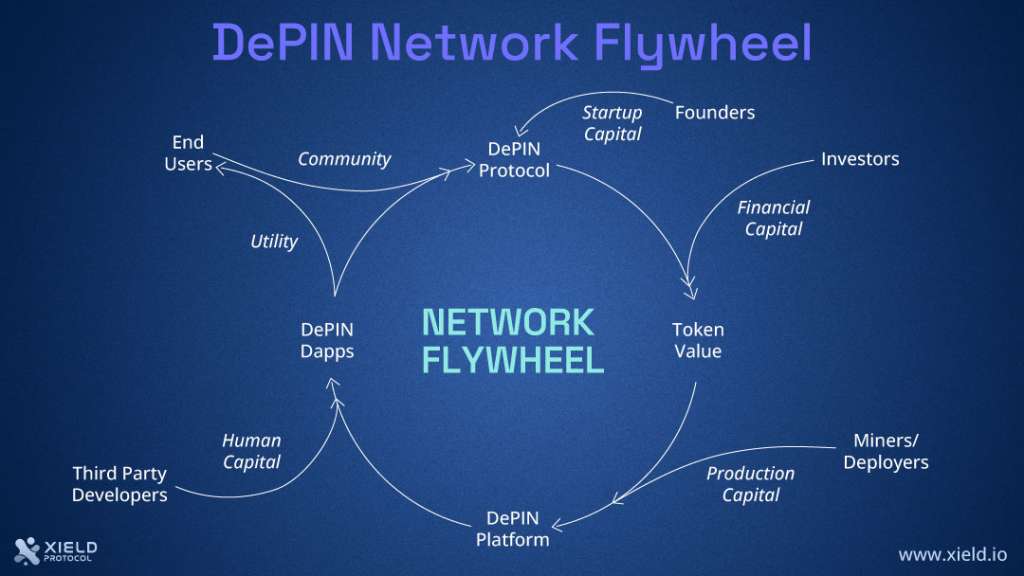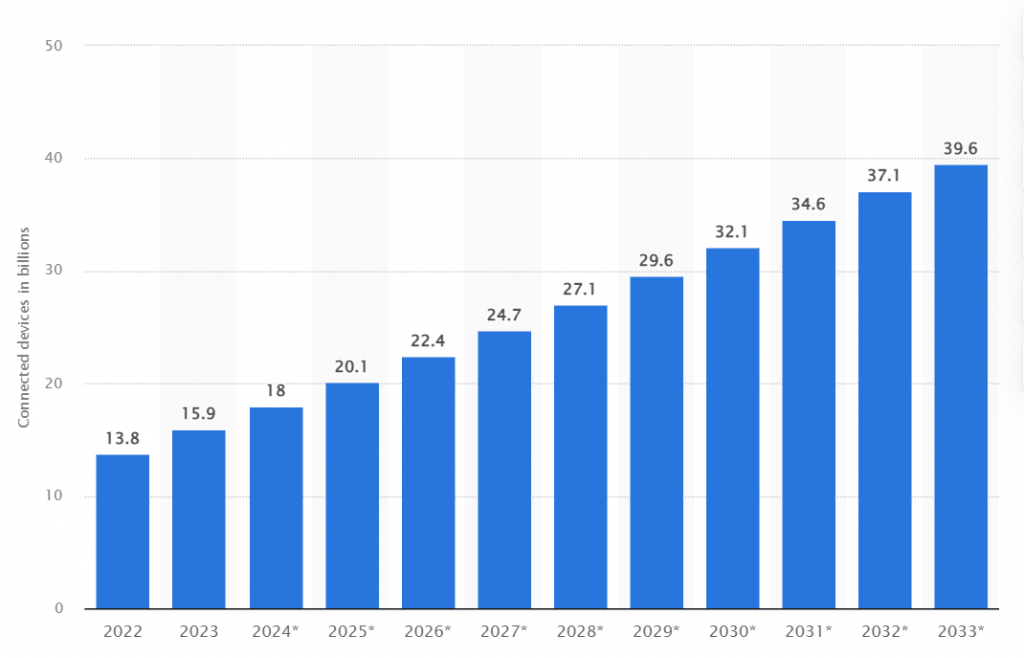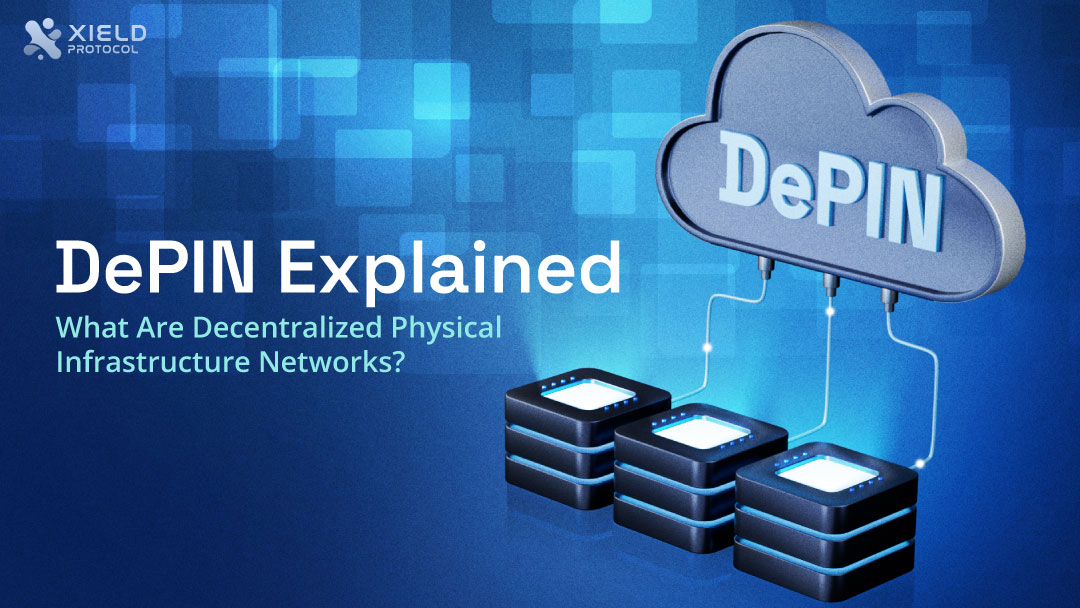In recent years, the field of decentralized technologies has grown well beyond digital currencies and blockchain applications. Decentralized Physical Infrastructure Networks, or DePINs, are a new technology that has piqued the interest of amateurs and professionals alike. These networks are a revolutionary approach to decentralization that applies the concepts of blockchain technology to physical infrastructure.
DePINs have the potential to transform how we interact with the physical world by enabling decentralized energy grids and transportation systems, as well as distributed storage solutions and autonomous delivery networks. As interest in DePIN protocols grows, driven by developments in blockchain technology and a rising desire for decentralized solutions, it is critical to grasp the principles of these networks and their consequences for the future.
Join us as we navigate the interesting world of DePINs and discover the reasons behind their ascent to popularity in decentralized infrastructure networks.
Understanding Decentralized Physical Infrastructure Networks (DePIN) in Crypto
DePIN is essentially a decentralized variation of the mechanism described above. The term stands for Decentralized Physical Infrastructure Network. A DePIN is a network of crowd-sourced providers who provide real-world services to users while using a public ledger (blockchain) to keep track of the services rendered and receive remitted rewards for these services via cryptocurrencies running on the same or a different blockchain network.
“Frankly, you have to think about [DePIN] as something much bigger than web-3 alone, and something that can impact the entire consumer product industry.” — Alex Rawitz Co-founder of DIMO
For DePINs, the blockchain serves as an administrative, remittance, and record-keeping service. As an administrative facility, DePINs employ the blockchain to provide a permissionless system for providers and consumers; anybody with adequate resources may supply the necessary services. As a remittance facility, customers gain services via blockchain-powered solutions, and suppliers are rewarded in cryptocurrency. As a record-keeping institution, every action is documented on the ledger, which is often open to the public.
DePINs are versatile. Their applicability spans across industries, from crowd-sourced geographical services to complex infrastructure markets that run entirely on the blockchain.
How Do DePINs Work?
DePINs work with the decentralized blockchain technology architecture, thereby spreading control and responsibility throughout a network rather than pooling it under a single body. At the core of the DePIN sector is a cryptocurrency-based economy that compensates members for giving resources such as computer power, internet connectivity, and storage capacity.
When the concept began, the majority of these DePIN crypto prizes had no actual worth, similar to early speculative investments. Participants acted primarily as “risk miners,” investing in the potential of emerging DePIN initiatives and seeking returns in the form of future token value increases and accumulation.
Every DePIN application is designed on four key pillars
- Physical network infrastructure comprises tangible assets required for network services, such as servers and transit systems.
- Off-chain computing solutions connect real-world contributions with blockchain incentives and provide smart contract data.
- The structure of a blockchain is a transparent and immutable ledger that uses smart contracts to control network transactions.
- The token incentives scheme promotes infrastructure contributions that fuel the network’s early development until it develops into a self-sustaining ecosystem supported by transaction fees.
The DePIN flywheel
DePIN projects often use the potential of their native cryptocurrencies to create a self-reinforcing loop known as the flywheel effect. As user interaction increases, so does demand for DePIN crypto tokens, which raises their market value.
DePINs intend to encourage the development of a resource-efficient physical infrastructure through incentives. First, providers must dedicate their physical resources to a decentralized network. In the quest for incentives, a large number of providers, some of whom may have these facilities idle, commit their resources to the network. DePIN makes these resources available to the user. The network produces cash via user fees.

Users are also drawn to the lower service prices compared to corporation-owned services. The network’s expansion piques the interest of investors, resulting in extra funding and support, which pushes network growth. Open-source projects and those that share data freely provide an ideal ground for developing dapps on top of this data layer, increasing the ecosystem’s value.
As the network increases, so does the value of the native token, resulting in more incentives for providers, increased interest from investors, and even more providers. As the cycle continues as the network grows, the DePIN flywheel accelerates.
Types of DePINS
DePINs, or Decentralized Physical Infrastructure Network, can have many different formats, depending on the device and its use. Here are a few typical types:
Physical Resource Networks (PRNs) and Digital Resource Networks (DRNs) are both systems for managing and optimizing resources, although they function in separate domains.
Physical Resource Networks (PRN)
- PRNs work with real resources such as raw materials, equipment, transportation, and facilities.
- They strive to optimize the movement of physical resources across supply chains, production processes, and distribution networks.
- PRNs may include logistics management, inventory control, production planning, and transportation optimization to guarantee that physical resources are used efficiently.
- Examples include typical manufacturing sectors, transportation and logistics firms, and supply chain management systems.
Digital Resource Networks (DRN)
- DRNs, on the other hand, work with intangible digital resources, including data, information, software, and services.
- They manage the flow of digital resources between platforms, networks, and systems.
- DRNs include procedures including data management, information exchange, digital collaboration, and software development.
- Examples of digital platforms include social media networks, cloud computing services, digital markets, and online collaboration tools.
While both PRNs and DRNs entail resource management and optimization, their focus and the resources they work with differ greatly. PRNs are concerned with physical assets and logistics, whereas DRNs are concerned with digital assets and information flow in the virtual world.
DePIN Will Drive the Next Wave of Adoption
By 2028, Alex’s globe will be filled with 25 billion smart devices. These gadgets are more than simply data collectors; they also generate passive money for their owners. As the world realizes the importance of data, DePIN’s promise resonates with everyone. From drivers like Alex to IT CEOs, hosting DePIN devices is rapidly becoming profitable enough to improve people’s lives.

Source: Statista
The Web3 age, formerly overshadowed by the speculative nature of bitcoin, is entering a productive period. People concerned about the unpredictable fluctuations of cryptocurrency see DePIN as a sensible and steady means to disrupt physical infrastructure. DePIN serves as a link between web3 and the real world, linking genuine demand to common gadgets.
Factors for Scaling DePIN Applications on Blockchain Infrastructure
Certain fundamental elements of the underlying blockchain infrastructure are required for DePIN applications to expand easily, and blockchains that incorporate these architectural considerations are more likely to support the expansion of a DePIN project.
Scalability
To meet the demands of decentralized physical networks, the blockchain must be able to handle a large number of transactions and data throughput.
Transaction Economics
DePIN applications often see a high volume of transactions, hence costs per transaction must be minimal to ensure their viability. As a result, an underlying blockchain that cannot handle increased transaction volumes while maintaining low transaction costs is unlikely to be suitable for DePIN applications.
Interoperability
The seamless connectivity with other blockchain networks and legacy systems is vital for DePIN applications to communicate and exchange data effectively.
Security
Robust security methods, including encryption, authentication, and consensus algorithms, are critical for protecting sensitive information and maintaining the integrity of DePIN networks.
Usability
User-friendly interfaces and intuitive design are essential for widespread adoption, allowing individuals and organizations to engage in DePIN ecosystems without specific technical knowledge.
Opportunities and Challenges
As the area of DePINs evolves, it presents both new potential and major obstacles. Understanding these characteristics is critical for realizing DePINs’ full potential while managing the complications of their deployment and development.
Opportunities
Innovation and Technology Advancement
DePINs allow cutting-edge infrastructure development by leveraging blockchain and smart contracts, resulting in more efficient, transparent, and robust systems. These developments cut costs, improve performance, and create new opportunities for applications and services that were previously limited by centralized structures.
Community Engagement and Empowerment
DePINs promote local involvement by rewarding donations to infrastructure projects. This strategy empowers communities by supporting sustainable and individualized solutions. Residents may earn tokens by building sustainable energy sources and contributing to decentralized energy systems.
Economic Expansion and New Revenue Streams
The token-based incentive paradigm creates economic potential. Participants may earn and exchange tokens, which boosts economic activity and promotes financial inclusion. Individuals, for example, who provide network coverage in decentralized wireless networks might receive tokens, resulting in a self-sustaining economic environment.
Environmental sustainability
DePINs promote renewable energy consumption and reduce dependency on fossil fuels, which helps to ensure environmental sustainability. Decentralized energy systems may include a variety of renewable sources, contributing to global efforts to mitigate climate change and promote sustainable development.
Challenges
Regulatory hurdles
Navigating various regulatory regimes presents a substantial challenge. Ensuring compliance while retaining decentralization necessitates careful management of regulatory obligations such as energy distribution and data privacy.
Scalability Issues
Scaling with DePIN initiatives to accommodate increased demand is difficult. Maintaining performance, security, and efficiency gets increasingly difficult as the number of participants increases. Solutions such as layer 2 scaling and sharding are being investigated to overcome these concerns.
User Adoption and Education
Encourage widespread usage and educate consumers about DePINs. Many potential participants may be unfamiliar with blockchain and decentralized models, which creates a barrier to entry. Educational activities and user-friendly interfaces are required to improve comprehension and engagement.
Benefits of DePIN
Horizontal Scalability
DePIN enables facilities to expand their capabilities more flexibly. Networks can expand resources rather than boost individual resource capability. This provides a high level of flexibility, and facilities designed with this method may quickly scale in and out according to demand. The blockchain may manage available resources and ration requests.
Community Control- Decentralization
DePIN, like DeFi, decentralizes infrastructure systems, shifting from companies to a group of individuals devoting money to establish a facility. This approach distributes facility control to many providers, which is analogous to miners in a PoW network. DePINs are a type of industrial DAO in which everyone in the system contributes resources and exercises control based on their capacity. In a system where all providers have equal capacity, the DePIN becomes (nearly) completely decentralized.
Fair pricing
DePIN pricing models differ from those used at conventional facilities. The pricing model takes into account the costs required by private providers to manage their separate facilities, as well as other network-related issues. Additional charges from the platform may be lower because the platform incurs no costs in providing these services.
Cost-effective Operation
The DePI network incurs minimal or no cost to bring the network to life; suppliers have a high amount of flexibility in terms of the services they offer. For example, a provider may commit their facility to numerous networks. Users also pay a reasonable fee for the services provided by the network. DePINs are designed to provide the best service at the lowest feasible cost, resulting in a cost-effective solution.
Permissionless
Anyone can contribute resources to a DePIN. Anyone can use the services provided by a DePIN. There is no negotiation about pricing or user screening for any of these. Once a provider has the necessary infrastructure, they can operate a provider-side account on a DePIN, just as anybody may deploy a liquidity pool on a DEX or acquire a loan from a money market without difficulty.
Incentivization
Incentivization is an excellent tool for DePINs. Depending on how the DePIN runs, suppliers might earn either passive or active money. Individuals can also get an income, mostly through DePINs. Nunet, for example, hopes to minimize the number of inactive computer resources by launching an AI-powered computing marketplace. Providers get revenue from facilities that were previously inert.
Closing Thoughts
DePINs represent a substantial advancement in infrastructure development by combining blockchain technology, smart contracts, and token-based incentives to produce more efficient, transparent, and robust systems. These networks decentralized control, improve security, and promote community engagement, resulting in creative, long-term infrastructure solutions.
DePINs outperform traditional models by removing single points of failure, stimulating economic growth through new income sources, and encouraging environmental sustainability through renewable energy integration. However, issues like regulatory compliance, scalability, security, interoperability, and user acceptance must be addressed. Regulatory frameworks involve cautious navigation, while scalability difficulties necessitate novel solutions such as layer 2 scaling, and security necessitates rigorous monitoring. Achieving interoperability and encouraging user education are critical to widespread adoption.
DePINs offer the potential to revolutionize infrastructure development by making it more inclusive, efficient, and sustainable. Collaborative efforts by developers, regulators, and communities are required to overcome obstacles and realize DePINs’ full potential, paving the way for a more decentralized and robust future.




